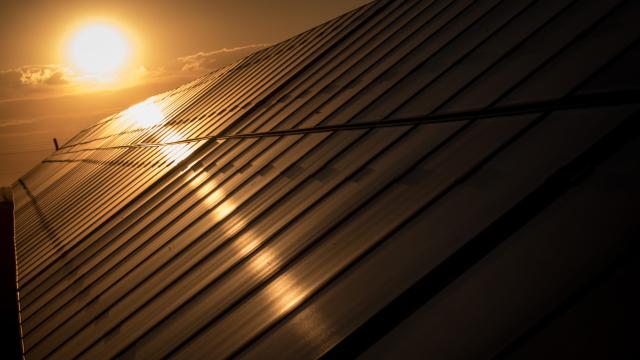Most solar panels capture sunlight from only one side, meaning they can capture more or less of it depending on where the sun is in the sky. In recent years, they’ve become far more efficient, typically converting around 22 per cent of the light they capture into energy.
In a new study published in the journal Joule on Tuesday, scientists put forth a way to boost that percentage even higher: double-sided solar panels that can move to follow the sun.
Compared with other innovations in the solar sector (like using a material called perovskite, which sounds like an ancient bug), this is a remarkably simple concept that could pay big dividends. Basically, these panels can capture sun from not only their sun-facing side but also from the light reflected off the ground onto their dark undersides. At the same time, a GPS allows them to tilt on an axis from east to west in order to always be pointed at an optimal angle to catch the sun’s rays.
Though double-sided solar panels and sun-following solar panels are both in use currently, models that combine the two technologies aren’t widely available for commercial use. Solar experts predict explosive growth in the market soon, though. And the new study shows that their widespread use will come with big economic and energy advantages.
By combining data from NASA’s Clouds and the Earth’s Radiant Energy System, field data on global sunlight patterns from three different institutes, and data on how much radiation a panel face can take in based on its orientation to the ground, the researchers looked into how cost efficient these newfangled panels could be. Their findings suggest that no matter where in the world you put them, they would be the most cost-effective form of solar panel.
The study authors determined that these two-sided sun-tracking panels produce an average of 35 per cent more energy than immobile single-panel systems, and are 16 per cent more cost-efficient. That holds true even when accounting for changes in weather conditions.
“This means that investing in bifacial and tracking systems should be a safe bet for the foreseeable future,” Carlos Rodríguez-Gallegos, the study’s lead author and a research fellow at the Solar Energy Research Institute of Singapore, said in a statement.
The same caveats for solar panels and their impact on the local environment apply to the double-sided, moving systems as well, if not more so. Lead used in solar panels can be one source of local pollution, and Dustin Mulvaney, an associate professor of environmental studies at San Jose State University and the author of Solar Power: Innovation, Sustainability, and Environmental Justice, who didn’t work on the study, told Earther in an email double-sided panels could mean “twice as much lead” as traditional solar systems.
He also raised issues around land use and ensuring natural surfaces aren’t painted over to max out the amount of energy collected by the bottom panels (something the study didn’t look at).
Since these new panels are more energy efficient, they could in theory save not only money but also land. That would require restructuring how solar contracts currently work, though it would be well worth it to ensure energy needs and conservation goals aren’t in opposition.
In the meantime, in places where they wouldn’t be disruptive to the environment, like white rooftops? That, Mulvaney said, “could be a nice fit.”
